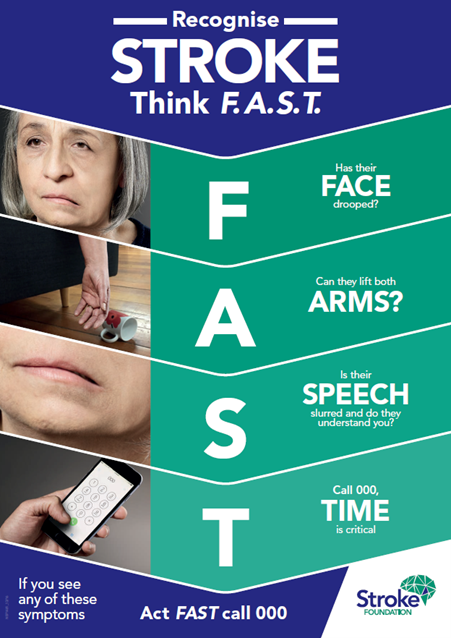8 – 14th August 2022
In light of National Stroke Week, we thought we’d help simplify for you what strokes are, the warning signs, the effects of a stroke and preventative measures.
“Stroke is one of Australia’s biggest killers and a leading cause of disability, but more than 80% of strokes can be prevented.” (Source: Stroke Foundation)
What is a stroke?
A stroke occurs when the supply of blood to the brain is reduced or blocked completely, which prevents brain tissue from getting oxygen and nutrients. As a result, the brain cells die due to lack of oxygen and nutrients.
There are three types of strokes.
Ischaemic Stroke:
An Ischemic stroke occurs when a blockage cuts off the blood supply to the brain. This can be caused by a blood clot or plaque.
Haemorrhagic Stroke:
A haemorrhagic stroke occurs when a weakened vessel ruptures, causing blood to leak into the brain. This stops the delivery of oxygen and nutrients.
Transient Ischemic Attack (TIA) :
A TIA is also called a warning or ministroke. A transient ischaemic attack occurs when the blood supply to your brain is blocked temporarily. The blockage clears and blood supply to the brain starts again, and the signs of a stroke disappear. TIAs should never be ignored, and you should always call 000 even if symptoms subside as this can be an indication of a larger stroke to come.
How do you know if someone is having a stroke?
The Stroke Foundation recommends the F.A.S.T. test. Think F.A.S.T., act FAST
Face: Check their face. Has their mouth drooped?
Arms: Can they lift both arms?
Speech: Is their speech slurred? Do they understand you?
Time: Is critical. If you see any of these signs call 000 straight away.
A stroke is always a medical emergency.
(Source: Stroke Foundation)
The effects of a stroke:
Every stroke is different. The effects depend on the type of stroke, location of the blocked or burst artery, what part of the brain is damage, etc.
Some problems people who have a stroke may experience include:
- Paralysis – Weakness on one side of the body
- Movement and sensation impairment
- Cognitive impairment (thinking, reasoning, judgement, memory)
- Speech difficulties and understanding
- Behavioral changes and uncontrollable outbursts of emotion
- Seizures
- Problems reading and writing
- Vision loss
- Incontinence
- Fatigue
- Depression
How can you prevent a stroke from occurring?
More than 80% of strokes can be prevented. So, what can you do to reduce your risk of having a stroke? Whilst we have included some lifestyle recommendations below to reduce your risk, there are some risk factors that you can’t do anything about. These include age, family history, gender or already having a prior stroke.
- Book in regular health assessments
- Stay active with regular physical exercise
- Healthy eating
- Decrease the amount of cholesterol and saturated fats in your diet
- Monitor you blood pressure
- Stop smoking
- Drink alcohol in moderation
“It is predicted that without action; by 2050, the number of first-ever strokes experienced by Australians annually will increase to 50,600 or one stroke every 10 minutes.” (Source: Stroke foundation 2020).
For more information about how we can help you with workplace education or health assessments, get in contact with [email protected] or call 0456 387 569.
